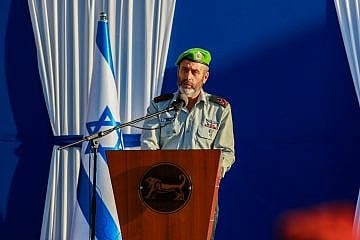Washington stated that the strike responds to Iran-backed militia attacks on U.S. forces in the region, including a drone strike that killed three soldiers in Jordan on Jan. 28.
Andrew Bernard
(JNS)
U.S. forces executed a drone strike on a car in Baghdad on Wednesday, killing a senior commander of the Iran-backed, Iraq-based Kata’ib Hezbollah terrorist group.
Washington stated that the strike, at about 1:30 p.m. East Standard Time, was the latest part of its response to Iran-backed militia attacks on U.S. forces in the region, including a drone strike that killed three U.S. soldiers in Jordan on Jan. 28.
U.S. Central Command “forces conducted a unilateral strike in Iraq in response to the attacks on U.S. service members, killing a Kata’ib Hezbollah commander responsible for directly planning and participating in attacks on U.S. forces in the region,” CENTCOM stated.
“There are no indications of collateral damage or civilian casualties at this time,” it added.
Unconfirmed images on social media suggest that that commander was Abu Baqir Al-Saadi, the head of Kata’ib Hezbollah’s operations in Syria. Despite the U.S. statement saying that only one commander was killed, regional media outlets reported that two other Kata’ib Hezbollah commanders also died in the drone strike.
Kata’ib Hezbollah, which the United States has designated a foreign terrorist organization since 2009, is an Iraq-based militia force that is part of Iran’s “axis of resistance” of proxies that has carried out more than 100 attacks on U.S. forces around the region since Oct. 7.
The U.S. response to those attacks began Friday with airstrikes on 85 targets at seven facilities in Iraq and Syria.
Hamas issued a statement on Telegram on Wednesday condemning the U.S. airstrike, holding the Biden administration responsible for the military escalation in the region over its support for Israel.
Image: A U.S. Air Force F-15E Strike Eagle flies over Iraq on May 5, 2018. The F-15E Strike Eagle is a dual-role fighter designed to perform air-to-air and air-to-ground missions. An array of avionics and electronics systems gives the F-15E the capability to fight at low altitude, day or night, and in all Credit: U.S. Air Force Photo by Staff Sgt. Corey Hook.
USCENTCOM Conducts Strike Killing Kata’ib Hezbollah Senior Leader
At 9:30 p.m. (Baghdad Time) February 7, U.S. Central Command (CENTCOM) forces conducted a unilateral strike in Iraq in response to the attacks on U.S. service members, killing a Kata’ib Hezbollah commander… pic.twitter.com/Zhkjimx5UG
— U.S. Central Command (@CENTCOM) February 7, 2024











